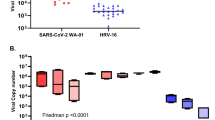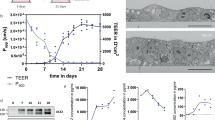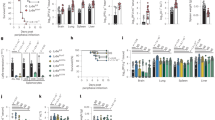Abstract
Recombinant Sendai virus (SeV)-mediated gene transfer to differentiated airway epithelial cells has shown to be very efficient, because of its ability to overcome the intra- and extracellular barriers known to limit gene delivery. However, this virus is transmission competent and therefore unlikely to be suitable for use in clinical trials. A nontransmissible, replication-competent recombinant SeV has recently been developed by deleting the envelope Fusion (F) protein gene (SeV/ΔF). Here we show that SeV/ΔF is able to mediate β-galactosidase reporter gene transfer to the respiratory tract of mice in vivo, as well as to human nasal epithelial cells in vitro. Further, in an ex vivo model of differentiated airway epithelium, SeV/ΔF gene transfer was not importantly inhibited by native mucus. When compared to the transmission-competent SeV in vivo, no difference in gene expression was observed at the time of peak expression. The development of an F-defective nontransmissible SeV, which can still efficiently mediate gene transfer to the airway epithelium, represents the first important step towards the use of a cytoplasmic RNA viral vector in clinical trials of gene therapy.
This is a preview of subscription content, access via your institution
Access options
Subscribe to this journal
Receive 12 print issues and online access
$259.00 per year
only $21.58 per issue
Buy this article
- Purchase on Springer Link
- Instant access to full article PDF
Prices may be subject to local taxes which are calculated during checkout







Similar content being viewed by others
References
Ferrari S, Geddes DM, Alton EWFW . Barriers and new approaches for gene therapy and gene delivery in cystic fibrosis. Adv Drug Deliv Rev 2002; 54: 1373–1393.
Ferrari S et al. Mucus altering agents as adjuncts for nonviral gene transfer to airway epithelium. Gene Therapy 2001; 8: 1380–1386.
Wang G et al. Increasing epithelial junction permeability enhances gene transfer to airway epithelia in vivo. Am J Respir Cell Mol Biol 2000; 22: 129–138.
Chu Q et al. EGTA enhancement of adenovirus-mediated gene transfer to mouse tracheal epithelium in vivo. Hum Gene Ther 2001; 12: 455–467.
Duan D et al. Endosomal processing limits gene transfer to polarized airway epithelia by adeno-associated virus. J Clin Invest 2000; 105: 1573–1587.
Kreda SM, Pickles RJ, Lazarowski ER, Boucher RC . G-protein-coupled receptors as targets for gene transfer vectors using natural small-molecules ligands. Nat Biotechnol 2000; 18: 635–640.
Kobinger GP, Weiner DJ, Yu QC, Wilson JM . Filovirus-pseudotyped lentiviral vector can efficiently and stably transduce airway epithelia in vivo. Nat Biotechnol 2001; 19: 225–230.
Zanta MA, Belguise-Valladier P, Behr JP . Gene delivery: a single nuclear localization signal peptide is sufficient to carry DNA to the cell nucleus. Proc Natl Acad Sci USA 1999; 96: 91–96.
Yonemitsu Y et al. Efficient gene transfer to airway epithelium using recombinant sendai virus. Nat Biotechnol 2000; 18: 970–973.
Griesenbach U et al. The nasal epithelium as a factory for systemic protein delivery. Mol Ther 2002; 5: 98–103.
Li HO et al. A cytoplasmic RNA vector derived from nontransmissible Sendai virus with efficient gene transfer and expression. J Virol 2000; 74: 6564–6569.
Dupuit F et al. Expression and localization of CFTR in the Rhesus monkey surface airway epithelium. Gene Therapy 1995; 2: 156–163.
Shoji F et al. Airway-directed gene transfer of interleukin-10 using recombinant Sendai virus effectively prevents post-transplant fibrous airway obliteration in mice. Gene Therapy 2003; 10: 213–218.
Yonemitsu Y et al. A preclinical safety study for intramuscular administration of F-defective, non-transmissible recombinant Sendai virus vector using non-human primate: toward a clinical study for ‘integrated’ therapeutic angiogenesis to treat subjects with critical limb ischemia. Mol Ther 2002; 5: S145–S146; abstr. 447.
Griesenbach U et al. Infection of the murine lung with non-transmissible recombinant Sendai virus expressing the secreted protein interleukin 10. Mol Ther 2002; 5: S174 abstr. 529.
Kato A et al. The paramyxovirus Sendai virus V protein encodes a luxury function required for pathogenesis. EMBO J 1997; 16: 578–598.
Hirata T et al. An improved method for recovery of F-defective Sendai virus expressing foreign genes from cloned cDNA. J Virol Methods 2002; 104: 125–133.
Kochanek S, Schiedner G, Volpers C . High-capacity ‘gutless’ adenoviral vectors. Curr Opin Mol Ther 2001; 3: 454–463.
Inoue M et al. Matrix and fusion genes-deficient Sendai virus vector: efficient gene transfer with preferable properties. Mol Ther 2002; 5: S174–S175; abstr. 530.
Inoue M et al. A new Sendai virus vector deficient in the matrix gene does not form virus particles and shows extensive cell-to-cell spreading. J Virol 2003; 77: 6419–6429.
Inoue M et al. Nontransmissible virus-like particle formation by F-deficient Sendai virus is temperature sensitive and reduced by mutations in M and HN proteins. J Virol 2003; 77: 3238–3246.
Yonemitsu Y, Kaneda Y . Hemagglutinating virus of Japan-liposome-mediated gene delivery to vascular cells. In: Baker EH (ed). Vascular Disease, Molecular Biology and Gene Transfer Protocols. Human Press: Totowa, NJ, 1999, pp 295–306.
Kitson C et al. The extra- and intracellular barriers to lipid and adenovirus-mediated pulmonary gene transfer in native sheep airway epithelium. Gene Therapy 1999; 6: 534–546.
Lee ER et al. Detailed analysis of structures and formulations of cationic lipids for efficient gene transfer to the lung. Hum Gene Ther 1996; 7: 1701–1717.
Ferrari S et al. ExGen 500 is an efficient vector for gene delivery to lung epithelial cells in vitro and in vivo. Gene Therapy 1997; 4: 1100–1106.
Acknowledgements
We thank M Festing for his help with statistical analysis. This study was supported by the UK Cystic Fibrosis Trust through a grant to the UK Cystic Fibrosis Gene Therapy Consortium (www.cfgenetherapy.org.uk) and by a Wellcome Trust Senior Clinical Fellowship (EWFWA).
Author information
Authors and Affiliations
Rights and permissions
About this article
Cite this article
Ferrari, S., Griesenbach, U., Shiraki-Iida, T. et al. A defective nontransmissible recombinant Sendai virus mediates efficient gene transfer to airway epithelium in vivo. Gene Ther 11, 1659–1664 (2004). https://doi.org/10.1038/sj.gt.3302334
Received:
Accepted:
Published:
Issue Date:
DOI: https://doi.org/10.1038/sj.gt.3302334
Keywords
This article is cited by
-
Nanotechnologies in delivery of mRNA therapeutics using nonviral vector-based delivery systems
Gene Therapy (2017)
-
Viral and Synthetic RNA Vector Technologies and Applications
Molecular Therapy (2016)
-
Development of a helper cell-dependent form of peste des petits ruminants virus: a system for making biosafe antigen
Veterinary Research (2015)
-
Validation of recombinant Sendai virus in a non-natural host model
Gene Therapy (2011)
-
Pushing the envelope in the lung
Gene Therapy (2011)



